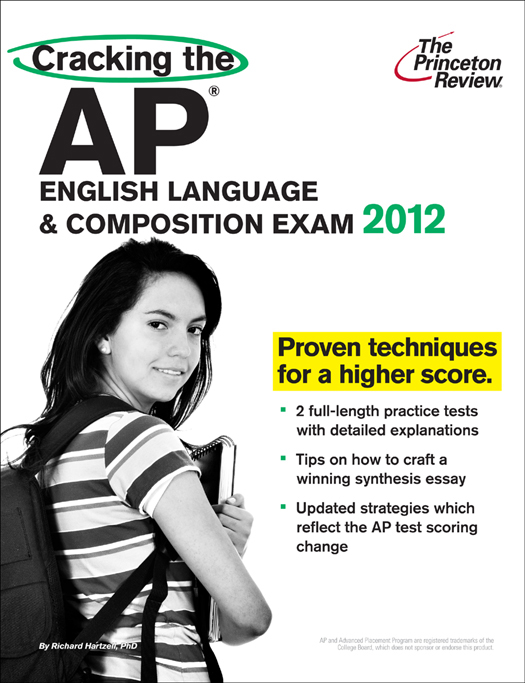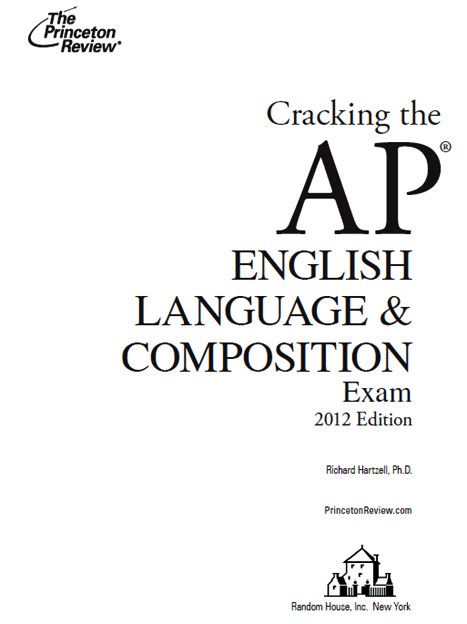
Editorial
Rob Franek, VP Test Prep Books, Publisher
Seamus Mullarkey, Associate Publisher
Laura Braswell, Senior Editor
Heather Brady, Editor
Selena Coppock, Editor
Random House Publishing Group
Tom Russell, Publisher
Nicole Benhabib, Publishing Manager
Ellen L. Reed, Production Manager
Alison Stoltzfus, Associate Managing Editor
The Princeton Review, Inc.
111 Speen Street, Suite 550
Framingham, MA 01701
E-mail:
The Princeton Review is not affiliated with Princeton University.
Copyright 2011 by Princeton Review Publishing
Cover design 2011 Random House, Inc.
Cover art Andres Rodriguez/Alamy
All rights reserved. Published in the United States by Random House, Inc., New York, and in Canada by Random House of Canada Limited, Toronto.
On Dumpster Diving by Lars Eighner. From Travels with Lizbeth. Copyright 1994. Reprinted by permission of Steven Saylor.
The Hairy Maid and the Harpsichord: Some Speculations on the Meaning of Gullivers Travels by Dennis Todd. Copyright 1992 by the University of Texas Press. Reprinted by permission of the University of Texas Press.
Farewell to Manzanar by James D. Houston and Jeanne Wakatsuki Houston. Copyright 1973 by James D. Houston. Reprinted by permission of Houghton Mifflin Harcourt Publishing Company. All rights reserved.
The End of Education by Neil Postman. Copyright 1995 by Neil Postman. Used by permission of Alfred A. Knopf, a division of Random House, Inc.
Phenomenal Woman, copyright 1978 by Maya Angelou, from And Still I Rise by Maya Angelou. Used by permission of Random House, Inc.
The Second Sex by Simone De Beauvoir, translated by H.R. Parshley, copyright 1952 and renewed 1980 by Alfred A. Knopf, a division of Random House, Inc. Used by permission of Alfred A. Knopf, a division of Random House, Inc.
Romanticism and its Discontents by Anita Brookner. Copyright 2000. Used by permission of Farrar, Straus and Giroux, LLC.
eISBN: 978-0-307-94442-9
ISSN: 1558-9676
Editor: Anya Yurchyshyn
Production Editor: Stephanie Tantum
2012 Edition
v3.1
ACKNOWLEDGMENTS
Even though there is only one author, a team of people contributed to the creation of this book.
First of all, I want to thank Paul Tipton for his sage counsel and Kamilla Khaydarov and Rachel Newman, who wrote the student essays. Also, thanks go to my assistant, Kathryn Lee. Her cheerful manner and professional support proved invaluable; I could not have completed the text without her help.
Thanks to Dawn Shepherd Wolfe and Jeff Soules, who updated and reviewed this book.
I cannot fail to mention both my wife, Susana, and Laura, who for months on end allowed me to replace them with my computer screen and tolerated the very, very occasional bouts of bad humor that resulted from my sequestration.
And finally Id like to thank my colleague and friend Robb Cutler for suggesting that I take on this project; I have forgiven him.
CONTENTS
Introduction
WHAT IS THE PRINCETON REVIEW?
The Princeton Review is an international test-preparation company with branches in all major U.S. cities and several cities abroad. In 1981, John Katzman started teaching an SAT prep course in his parents living room. Within five years, The Princeton Review had become the largest SAT prep program in the country.
Our phenomenal success in improving students scores on standardized tests is due to a simple, innovative, and radically effective philosophy: Study the test, not just what the test claims to test. This approach has led to the development of techniques for taking standardized tests, techniques based on the principles the test writers themselves use to write the tests.
The Princeton Review has found that its methods work not just for Cracking the SAT, but for any standardized test. Weve already successfully applied our system to the GMAT, LSAT, MCAT, and GRE, to name just a few. Obviously you need to be well versed in language and grammar to do well on the AP English Language and Composition Exam, but you should remember that any standardized test is partly a measure of your ability to think like the people who write standardized tests. This book will help you to brush up on your AP English Language and Composition skills and to prepare for the exam using our time-tested principle: Crack the system based on how the test is created.
We also offer books and online services that cover an enormous variety of education and career-related topics. If youre interested, check out our website at PrincetonReview.com.

H OW TO W ORK W ITH THE F REE R ESPONSE AND E SSAY S ECTIONS IN THIS E B OOK
Throughout this ebook youll encounter free-response and essay questions, just like youll see on the real exam. When working through them, look for the pencil-and-paper icon above. You can either fill out your answers on a separate piece of paper to mimic your actual testing experience, or use the Notes functionality on your eReader.
If you are using a touch-screen reader or app, simply hold your finger over the first word in the line and then select Note to create a note and begin typing your answer.
If you are using a non-touch-screen reader, move your cursor up to the line where you want to enter an answer and then begin typing to create a new note.
You can then reference your answers anytime you are reading the eBook as they will be stored as notes on your device.
PART I
Welcome to the Exam
1
A Brief Introduction
to the AP English
Language and
Composition Exam
WHY DO YOU NEED THIS BOOK?
This book was written for a student whose goal is to achieve the best possible score on the AP English Language and Composition Exam. We at The Princeton Review believe that the best way to achieve this goal is to understand the testand especially how the test is written. If you understand the limitations that test writers face, you will approach the test in a way that enables you to earn your maximum scoreand thats probably what matters most to you right now. Even if your English Language teacher spends most of the class time discussing her favorite books instead of teaching you about rhetoric, you can still ace the exam with the help of this book. However, if you had excellent English instruction in a course specifically centering on the nuts and bolts of AP English Language, then this book will help you review what you learned and give you valuable test-taking strategies that will ensure your success.
Despite the diversity that might result from differing teachers and curricula, the courses share a common task: to teach you to read and write English at a college level. Likewise, the AP English Language and Composition Exam shares the same goalit attempts to test you on whether you read and write English at a college level.






